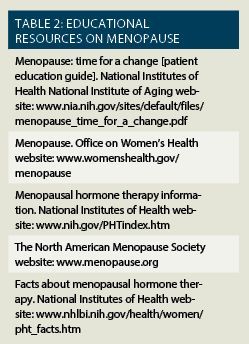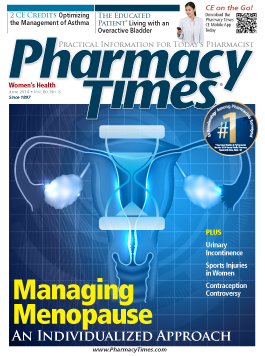Publication
Article
Pharmacy Times
Managing Menopause: An Individualized Approach
Author(s):
Menopause affects every woman differently, so most clinicians recommend an individualized approach.
Menopause affects every woman differently, so most clinicians recommend an individualized approach.
Hot flashes, chills, night sweats, trouble sleeping, weight gain, oh my!
Menopause is a natural and inevitable part of life for every woman, and this transition may present challenges that affect a woman’s quality of life, sleep pattern, and daily routine. Because the onset of menopause affects every woman differently, most clinicians recommend taking an individualized approach to managing the bothersome symptoms of menopause.
The average age of onset of menopause is between 50 and 52 years; however, most women begin to experience menopause symptoms between 44 and 55 years of age.1,2 Physiologic menopause is defined as the absence of menses for 1 year.1,2 The onset of menopause symptoms, which is called perimenopause, occurs in most women between 45 and 47 years of age.1-4 During this phase of life, a woman may start to experience changes in her menstrual cycle, such as a change in the amount or length of her menstrual flow as well as irregular or missed menstrual cycles.3,4
Signs and Symptoms
During perimenopause and menopause, a woman may experience a host of symptoms that can vary in rate of occurrence and in severity. Some women may ease through this transition, while others may struggle with a variety of symptoms. Vasomotor symptoms such as hot flashes are considered to be the most prevalent, affecting 50% of women during perimenopause and menopause, according to estimates.1-4 A hot flash episode may last from 30 seconds to 5 minutes, and sometimes women experience chills afterward.4 Common triggers of hot flashes include ingestion of caffeine, alcohol, or spicy foods; smoking; wearing tight clothing; and eating foods that contain nitrates or nitrites.1-4 Other common symptoms include irregular menstrual cycles, other vasomotor symptoms (eg, night sweats), dizziness, mood swings, insomnia or other sleep disturbances, headaches, weight gain, and fatigue.1-4
Products for Managing Menopause
Pharmacists are likely to encounter patients seeking counseling on the management of menopause symptoms and the available treatment options. Several nonprescription products are marketed to relieve menopause symptoms (Online Table 1). Many patients may elect to use these supplements because of concerns about hormone replacement therapy.5
Table 1: Examples of Nonprescription Products Marketed for Managing Menopause Symptoms
Emerita Menopause Plus Formula Dietary Supplement
Estroven Maximum Strength Natural Menopause Relief
Estroven Weight Management
Estroven Nighttime
Estroven Mood & Memory
Estroven Energy
Estroven Femcare
Enzymatic AM/PM PeriMenopause Formula
Enzymatic AM/PM Menopause Formula
GNC Women’s Menopause Formula
Healthy Woman Soy Menopause Supplement Tablets
i-cool Bone Builder + D for Menopause
i-cool for Menopause
i-cool Hot Flash Relief Cloths
Midnite for Menopause dietary supplement
NaturaNectar Easefemin Menopausal Support dietary supplement
Nature’s Bounty Complete Menopause Support Complex dietary supplement
Natrol Menopause Formula
Natrol Complete Balance AM/PM for Menopause
Natrol Black Cohosh
Natrol Soy Isoflavone
Natrol Hot Flashex
Nature’s Way Change-O-Life Herb Blend
Nature’s Way EstroSoy
Nature’s Way EstroSoy Plus
Nature’s Way Soy Isoflavones
Nature’s Way Black Cohosh Root
New Phase Complete Menopause Support
One A Day Women's Menopause Formula
Options Healthy Woman
Promensil Menopause
Remifemin Estrogen Free Good Night dietary supplement
Remifemin Menopause Relief herbal supplement
Soy Care for Menopause
WINDMILL Menoprim Nutritional Support for Menopausal Women
Zand Changes for Women, Day & Night Formula
Products for managing menopause symptoms include herbal and alternative remedies that may contain phytoestrogens (plant estrogens, isoflavones), black cohosh, vitamin E, evening primrose oil, and/or chaste tree berry. These products are available in single-entity or combination formulations, and many are formulated with vitamins, minerals, and alternative sleep aids. There are also multivitamin/multimineral dietary supplements such as One A Day Women’s Menopause Formula (Bayer Healthcare LLC), which is formulated with natural soy isoflavones and other nutrients to decrease the incidence of hot flashes and mild mood changes.6
i-Health, Inc—the manufacturer of Estroven menopause supplement products—has introduced the new weight-management formula Estroven Weight Management, and Estroven Femcare, which is marketed to decrease hot flashes, night sweats, and mood changes. The manufacturer has also released new and improved formulations of Estroven Maximum Strength, Estroven Nighttime, and Estroven Mood & Memory. In addition, i-Health, Inc, markets the new product i-Cool Hot Flash Relief Cloths.
Because many products for treating and managing menopausal symptoms are on the market, the selection of an appropriate product may be overwhelming and challenging for many women. By providing information on how to effectively manage menopause symptoms, pharmacists can be instrumental in helping women select appropriate products. Pharmacists can also provide patients with key information about the safety and efficacy of these products, as well as the potential adverse effects associated with their use.
Many products are formulated with phytoestrogens, including soy products and red clover products, which are derived from plants and have been used primarily for managing menopause symptoms.7 Isoflavones may cause adverse effects such as gastrointestinal (GI) problems, headaches, and allergic reactions.7 Because the long-term effects of phytoestrogens have not been fully established, especially among individuals with an increased risk of estrogen-dependent cancers and thromboembolic disorders, use of these products should be avoided in these patients.7 Patients should be encouraged to discuss these issues with their primary health care provider.
Black cohosh is found in many supplements for managing menopause symptoms and is derived from the dried rhizome and roots of Cimicifuga racemosa.7 Adverse effects associated with the use of black cohosh include GI effects, headache, rash, nausea, dizziness, weight gain, and acute hepatitis.7 Using black cohosh for more than 6 months is not recommended because there are insufficient data regarding the effects of long-term use.7
Clinical Trials
Results from clinical studies show that soy isoflavones may provide relief from vasomotor symptoms such as hot flashes, but results from various studies are still inconclusive.7-10 However, a 2011 study reported a significant decrease in vasomotor symptoms when isoflavones were used.7,8 While there is still great debate about the efficacy of soy isoflavones, the North American Menopause Society (NAMS) recommends 50 mg/day of soy isoflavones for treating vasomotor symptoms, when appropriate.8,9 If symptoms do not resolve, NAMS recommends a trial using an alternate therapy.8,9 Several clinical trials evaluating the safety and efficacy of black cohosh have had mixed results; there are currently insufficient clinical data regarding the use of black cohosh for menopausal symptoms.7,8,11
Research regarding the use of these supplements is ongoing. For more in-depth information on these supplements, menopausal symptoms, and ongoing studies, visit the National Institutes of Health National Center for Complementary and Alternative Medicine website at http://nccam.nih.gov/health/menopause/menopausesymptoms.htm.

Patients should always be advised to discuss the use of products to relieve menopause symptoms with their primary health care before they are used, especially if patients have preexisting medical conditions or are taking any other medications. This can help patients become aware of contraindications and avoid potential drug interactions, as well as confirm that a medication is appropriate. Patients electing to use the supplements discussed above should be counseled on the potential adverse effects associated with their use. Patients experiencing severe and unmanageable symptoms should be encouraged to talk to their primary health care provider about the best treatment options for managing their menopausal symptoms.
When a woman reaches menopause, the risk of developing cardiovascular disease and osteoporosis can increase; therefore, it is imperative that postmenopausal women discuss these issues as well as preventive and treatment measures with their primary health care provider. During patient counseling, pharmacists can discuss nonpharmacologic measures that may help provide symptomatic relief, remind patients of the potential triggers of vasomotor symptoms, and direct patients to the online educational resources (Table 2). To manage vasomotor symptoms, The American College of Obstetricians and Gynecologists recommends that patients wear layered clothing, lower the room temperature, and consume cool drinks.12 It is also important to remind patients to maintain routine medical visits and incorporate lifestyle modifications such as practicing relaxation techniques (eg, yoga), getting sufficient rest, eating a well-balanced diet, and establishing some type of exercise routine.
Menopause may present challenges and require women to make adjustments. Pharmacists can encourage women to take charge of their overall health and learn how to manage menopause symptoms effectively and safely.
Ms. Terrie is a clinical pharmacy writer based in Haymarket, Virginia.
References
- Menopause. US Department of Health & Human Services Office on Women’s Health website. http://womenshealth.gov/menopause. Accessed May 1, 2014.
- Menopausal symptoms and complementary health practices. National Institutes of Health National Center for Complementary and Alternative Medicine website. http://nccam.nih.gov/health/menopause/menopausesymptoms.htm. Accessed May 1, 2014.
- Gold E. The timing of the age at which natural menopause occurs. Obstet Gynecol Clin North Am. 2011;38(3):425-440.
- Menopause. Merck Manual for Health Care Professionals website. www.merck.com/mmpe/sec18/ch245/ch245a.html#sec18-ch245-ch245a-193b. Accessed May 1, 2014.
- Bedell S, Nachtigall M, Naftolin F. The pros and cons of plant estrogens for menopause. J Steroid Biochem Mol Biol. 2014;139:225-236.
- One A Day Menopause Formula [package insert]. Whippany, NJ: Bayer Healthcare LLC; 2013.
- McQueen C, Orr K. Natural products. In: Krinsky D, Berardi R, Ferreri S, et al, eds. Handbook of Nonprescription Drugs. 17th ed. Washington, DC: American Pharmacists Association; 2012.
- Glassy C. “Alternative” cures for hot flashes: worthwhile, or a waste? Medscape website. www.medscape.com/viewarticle/822488_3. Accessed May 1, 2014.
- North American Menopause Society. The role of soy isoflavones in menopausal health: report of the North American Menopause Society/Wulf H [abstract]. Menopause. 2011;18:732-753.
- Menopausal symptoms and complementary health practices. National Institutes of Health National Center for Complementary and Alternative Medicine website. http://nccam.nih.gov/health/menopause/menopausesymptoms. Accessed May 1, 2014.
- Leach MJ, Moore V. Black cohosh (Cimicifuga spp) for menopausal symptoms. Cochrane Database Syst Rev. 2012;9.
- New guidelines issued on menopausal symptom management. Medscape website. www.medscape.org/viewarticle/818509. Accessed May 1, 2014.







